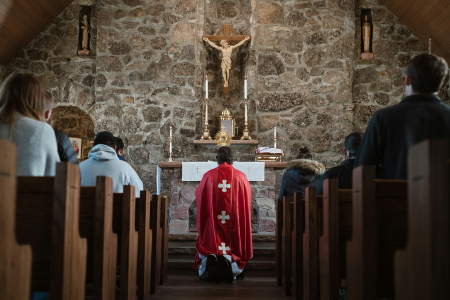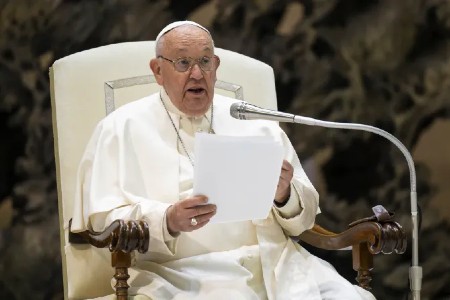We ask you, humbly: don't scroll away.
Hi readers, it seems you use Catholic Online a lot; that's great! It's a little awkward to ask, but we need your help. If you have already donated, we sincerely thank you. We're not salespeople, but we depend on donations averaging $14.76 and fewer than 1% of readers give. If you donate just $5.00, the price of your coffee, Catholic Online School could keep thriving. Thank you.Help Now >
Gloria in Excelsis Deo
FREE Catholic Classes
The great doxology ( hymnus angelicus ) in the Mass is a version of a very old Greek form". It begins with the words sung by the angels at Christ's birth ( Luke 2:14 ). To this verse others were added very early, forming a doxology. In a slightly different form it occurs at the beginning of a "morning prayer ( proseuche eothine )" in the "Apostolic Constitutions", VII, xlvii. This text, which has a subordination colouring ( su monos kyrios Iesou Christou ), will be found in Duchesne, "Origines du Culte chretien" (2nd ed., Paris, 1898, p.158, n.I). It goes back at least to the third century; Probst (Lehre und Gebet der drei ersten christl. Jahrhunderte", Tübingen, 1870, p.290) thinks even to the first. A very similar form is found in the Codex Alexandrinus (fifth century) and in Pseudo-Athanasius, "de Virginitate", §20 (before the fourth century), in P.G. XXVIII, 275. Extended further and with every trace of subordinationism corrected, it is sung by the Byzantine Church at the Orthros. In this form it has more verses than in the Latin, and ends with the Trisagion ( horologion to mega , Rome, 1876, p.57). It is not used in the Liturgy by any Eastern Church. Only the first clause (the text of Luke ii, 14) occurs as part of the people's answer to the words, "Holy things for the holy ", at the elevation in the Liturgy of the Apostolic Constitutions (Brightman, Eastern Liturgies, Oxford, 1896, p. 25), as part of the Offertory and Communion prayers in St. James's Liturgy (ibid., pp. 45, 64), at the kiss of peace in the Abyssinian Rite (p. 227), in the Nestorian Prothesis (p. 248) and again at the beginning of their Liturgy (p. 252), in the Byzantine Prothesis (p. 361). The tradition is that it was translated into Latin by St. Hilary of Poitiers (d. 366). It is quite possible that he learned it during his exile in the East (360) and brought back a version of it with him (so Belethus, "Rationale divinorum officiorum", c. 36; Duandus "Rationale", IV, 13, who thinks that he only added from "Laudamus te" to the Mass, and notes that Innocent III attributes it to Telesphorus, others to Symmachus). In any case, the Latin version differs from the present Greek form. They correspond down to the end of the Latin, which however adds: "Tu solus altissimus" and "Cum sancto Spiritu". The Greek then goes on: "Every day I will bless thee and will glorify thy name for ever, and for ever and ever" and continues with ten more verses, chiefly from psalms, to the Trisagion and Gloria Patri.
The "Liber pontificalis" says " Pope Telesphorus [128-139?] ordered that . . . on the Birth of the Lord Masses should be said at night . . . and that the angelic hymn, that is Gloria in Excelsis Deo, should be said before the sacrifice" (ed. Duchesne, I, 129); also "that Pope Symmachus [498-514] ordered that the hymn, Gloria in excelsis, should be said every Sunday and on the feasts [natalicia] of martyrs." The Gloria is to be said in its present place, after the " Introit " and "Kyrie", but only by bishops (ibid., 263). We see it then introduced first for Christmas, on the feast to which it specially belongs, then extended to Sundays and certain great feasts, but only for bishops. The "Ordo Romanus I" says that when the Kyrie is finished "the pontiff, turning towards the people, begins Gloria in Excelsis, if it be the occasion for it [si tempus fuerit]" and notes specially that priests may say it only at Easter (ed. C. Atchley, London, 1905, pp.130, 148). The "Ordo of St. Amand" (Duchesne, "Origines", appendix, p. 460) gives them leave to do so only on Easter Eve and on the day of their ordination. The Gregorian Sacramentary (dicitur Gloria in excelsis Deo, si episcopus fuerit, tantummodo die dominico sive diebus festis; a presbyteris autem minime dicitur nisi solo in Pascha) and Walafrid Strabo, "Liber de exordiis", c.22, in P.L., CXIV, 945, note the same thing. Berno of Constance thinks it a grievance still in the eleventh century (Libellus de quibusdam rebus ad Missæ officium pertinentibus, c.2, in P.L., CXLII, 1059). But towards the end of the same century the Gloria was said by priests as well as by bishops. The "Micrologus" (by the same Berno of Constance, 1048) tells us that "On every feast that has a full office, except in Advent and Septuagesima, and on the feast of the Innocents both the priests and the bishop say Gloria in excelsis (c. ii). It then became, as it is now, an element of every Mass except in times of penance. Even in Advent, until it began to be considered such a time, it was said. As early as Amalarius of Metz (ninth century) (De officiis eccl. libri IV, IV, 30), it was said during Advent "in some places". This would apply, of course, to bishops' Masses on Sundays and feasts at that time. So also Honorius of Autun (1145) in the twelfth century, "Gemma animæ", III, 1. White vestments were used, and the Gloria said, in Rome during Advent to the end of the twelfth century, "Ordo Romanus XI", 4. After that, Advent was gradually considered a time of penance in imitation of Lent. The Te Deum and Gloria were left out during it, and the use of purple vestments introduced.
The so-called farced Glorias were a medieval development. As in the case of the Kyrie, verses were introduced into its text for special occasions. Such expanded forms were very popular, especially one for feasts of the Blessed Virgin that seems to have been used all over Europe. Thus in the Sarum Missal, after the words "Domine Fili unigenite, Jesu Christe", "Spiritus et alme orphanorum paraclyte" is added; after "Filius Patria" is inserted "Primogenitus Mariæ virginis matris". Again: "Suscipe deprecationem nostram, ad Mariæ gloriam", and the end: "Quoniam tu solus sanctus, Mariam sanctificans, Tu solus Dominus, Mariam gubernans. Tu solus altissimus, Mariam coronans, Jesu Christe" (ed. Burntisland, 1861-1883, col. 585-6). The following rubric says: "In omnibus aliis missis quando dicendum est, dicitur sine prosa"; that is, in other Masses than those of the B.V.M., the additional tropes -- called prosa -- are to be omitted. These tropes added to liturgical texts ad libitum were contained in special books, "Libri troparii". In spite of repeated commands to expunge them, they were still sung in places when the Missal was revised by order of Pius V in 1570. In the Bull "Quo primum" of that year (printed at the beginning of the Missal ) the pope forbids anything to be added to, or changed in, the text of the books then published. The popularity of the forms about the Blessed Virgin accounts for the rubric in the Missal after the Gloria: "Sic dicitur Gloria in excelsis, etiam in missis B. Mariæ quando dicendum est." Since then these "farced" forms have happily disappeared. It may be noted here that the Gloria, originally foreign to the Milanese and Mozarabic RiteRites, has displaced the older Trisagion in them since the seventh century -- an obvious Roman importation (Duchesne, op. cit., p.183 and note).
The present law about the use of the Gloria is given by the "Rubricæ generales" of the Missal, VIII, 3. It is to be said in Mass whenever the Te Deum is said at Matins -- with two exceptions. It is therefore omitted on ferias (except in Easter-tide ), Ember days, vigils, during Advent, and from Septuagesima till Easter, when the Mass is de tempore . The feast of Holy Innocents, but not its octave, is kept with purple vestments and without the Te Deum or Gloria. We have seen this already in the "Micrologus" above). Nor is the Gloria said at Requiem or votive Masses, with three exceptions: votive Masses of the Blessed Virgin on Saturdays, of Angels, and those said "pro re gravi" or for a public cause of the Church, unless with purple vestments, have the Gloria. The two cases in which it occurs without the Te Deum in the Office are Maunday Thursday (when the whole Mass is an exception in Passion-tide and has no correspondence with the canonical hours ) and Holy Saturday in the first Easter Mass. The Gloria always involves "Ite missa est" at the end of Mass. When it is not said that versicle is changed to "Benedicamus Domino" or, in Requiems, to "Requiescant in pace."
 Hi readers, it seems you use Catholic Online a lot; that's great! It's a little awkward to ask, but we need your help. If you have already donated, we sincerely thank you. We're not salespeople, but we depend on donations averaging $14.76 and fewer than 1% of readers give. If you donate just $5.00, the price of your coffee, Catholic Online School could keep thriving. Thank you. Help Now >
Hi readers, it seems you use Catholic Online a lot; that's great! It's a little awkward to ask, but we need your help. If you have already donated, we sincerely thank you. We're not salespeople, but we depend on donations averaging $14.76 and fewer than 1% of readers give. If you donate just $5.00, the price of your coffee, Catholic Online School could keep thriving. Thank you. Help Now >
The manner of saying it is described in the "Ritus celebrandi Missam", IV, 7. In the "Ordo Romanus I" (above) the celebrant turns to the people to say the first words. That is no longer observed. At high Mass as soon as the Kyrie is finished the celebrant facing the altar in the middle, intones: "Gloria in excelsis Deo", raising, joining, and lowering his hands and bowing his head at the word Deo . Meanwhile the deacon and subdeacon stand behind him in line. They then come to his right and left and with him continue the Gloria in a low voice. All bow at the holy name (it occurs twice) and at the words: "Adoramus te", "Gratias agimus tibi", "Suscipe deprecationem nostram" and make the sign of the cross at the last clause. They then go per viam breviorem (genuflecting first, according to the usual rule) to the sedilia and sit. Meanwhile the choir immediately continues: "Et in terra pax ", and sings the text straight through. In the former Missal four chants were printed for the celebrant's intonation (for Doubles, Masses of B.V.M., Sundays, and Simples). This intonation ought to be in every way part -- the beginning -- of the melody continued by the choir; so in the new ("Vatican") edition of the missal, eighteen alternative chants are given, one for each Gloria in the Gradual. Obviously, when a plain-song Mass is sung, the celebrant should intone the Gloria to the same chant (and at the same pitch) as its continuation by the choir. The ideal is for the choir to go on at once without any sort of prelude by the organ ; "Et in terra pax " etc. is the second half of the same sentence as "Gloria in excelsis Deo". In a figured Mass so exact a correspondence is not possible. But in any case the choir may never repeat the celebrant's words. Every Gloria in a figured Mass must begin: "Et in terra pax ". The custom -- once very common -- of ignoring the celebrant and beginning again "Gloria in excelsis" is an unpardonable abomination that should be put down without mercy, if it still exists anywhere. While the Gloria is sung, the celebrant, ministers, and servers bow (or uncover) at the holy name and the other clauses, as above. During the last clause the celebrant and ministers rise and go to the altar per viam longiorem (genuflecting at the foot, according to rule) and go to their places for the "Dominus vobiscum before the Collect. At a sung Mass the same order is observed by the celebrant alone. At low Mass he recites the Gloria straight through clara voce , making the sign of the cross during the last clause (In gloria Dei Patris. Amen ).
Mystic and edifying reflections on the Gloria will be found in Durandus and Gihr (see below). Durandus sees much symbolism in the fact that the Church (that is, men) continues the angels' hymn. By the birth of Christ who restores all things in heaven and on earth ( Ephesians 1:10 ), angels and men, separated by original sin, are now reconciled; men may now hope some day to join in the angels' hymns. Gihr gives a devotional commentary on the text, word for word. He sees a mystic reason for the order of the words: Laudamus, benedicimus, adoramus, glorificamus. One may be edified by such considerations without attributing so much sublety to the unknown subordinationist who apparently first arranged them. It will be noticed that the Gloria is a hymn of praise addressed to each Person of the Holy Trinity in turn, although the clause about the Holy Ghost is very short (cum sancto Spiritu) and is evidently an afterthought. It does not occur in the text of the Apostolic Constitutions. It will also be seen that the clauses are arranged in parallels with a certain loose rhythm. This rhythm is much more evident in the Greek original (measured of course by accent); for instance:
Kyrie basileu epouranie,Thee pater pantokrator
Lastly, it would be difficult to find in any Liturgy a more beautiful example of poetry than our hymnus angelicus . The Gloria and the Te Deum are the only remains we now have of the psalmi idiotici (psalms composed by private persons instead of being taken from the Biblical Psalter ) that were so popular in the second and third centuries. These private psalms easily became organs for heretical ideas, and so fell into disfavour by the fourth century (Batiffol, "Histoire du Bréviaire romain", Paris, 1895, 9-12). The extraodinary beauty of these two (to which one should add the phos hilaron ) is a witness to the splendour of that outburst of lyric poetry among Christians during the time of persecution.
We ask you, humbly: don't scroll away.
Hi readers, it seems you use Catholic Online a lot; that's great! It's a little awkward to ask, but we need your help. If you have already donated, we sincerely thank you. We're not salespeople, but we depend on donations averaging $14.76 and fewer than 1% of readers give. If you donate just $5.00, the price of your coffee, Catholic Online School could keep thriving. Thank you.Help Now >
Join the Movement
When you sign up below, you don't just join an email list - you're joining an entire movement for Free world class Catholic education.
-

-
Mysteries of the Rosary
-
St. Faustina Kowalska
-
Litany of the Blessed Virgin Mary
-
Saint of the Day for Wednesday, Oct 4th, 2023
-
Popular Saints
-
St. Francis of Assisi
-
Bible
-
Female / Women Saints
-
7 Morning Prayers you need to get your day started with God
-
Litany of the Blessed Virgin Mary
U.S. Catholic Parishes Experience Resurgence of Traditional Practices
-

Pope Francis Urges Faith and Prayers for Peace
-

Florida Welcomes Volunteer Chaplains to Public Schools
-
10 Fascinating Details About St. Joseph the Worker: Celebrating His Feast Day - May 1
-
St. Joseph the Worker: Model for Men, Young and Old
Daily Catholic
 Daily Readings for Thursday, May 02, 2024
Daily Readings for Thursday, May 02, 2024 St. Athanasius: Saint of the Day for Thursday, May 02, 2024
St. Athanasius: Saint of the Day for Thursday, May 02, 2024 The Our Father: Prayer of the Day for Thursday, May 02, 2024
The Our Father: Prayer of the Day for Thursday, May 02, 2024- Daily Readings for Wednesday, May 01, 2024
- St. Marculf: Saint of the Day for Wednesday, May 01, 2024
- To Saint Peregrine: Prayer of the Day for Wednesday, May 01, 2024
![]()
Copyright 2024 Catholic Online. All materials contained on this site, whether written, audible or visual are the exclusive property of Catholic Online and are protected under U.S. and International copyright laws, © Copyright 2024 Catholic Online. Any unauthorized use, without prior written consent of Catholic Online is strictly forbidden and prohibited.
Catholic Online is a Project of Your Catholic Voice Foundation, a Not-for-Profit Corporation. Your Catholic Voice Foundation has been granted a recognition of tax exemption under Section 501(c)(3) of the Internal Revenue Code. Federal Tax Identification Number: 81-0596847. Your gift is tax-deductible as allowed by law.










 Daily Readings for Thursday, May 02, 2024
Daily Readings for Thursday, May 02, 2024 St. Athanasius: Saint of the Day for Thursday, May 02, 2024
St. Athanasius: Saint of the Day for Thursday, May 02, 2024 The Our Father: Prayer of the Day for Thursday, May 02, 2024
The Our Father: Prayer of the Day for Thursday, May 02, 2024

